




Your support is critical to our success.
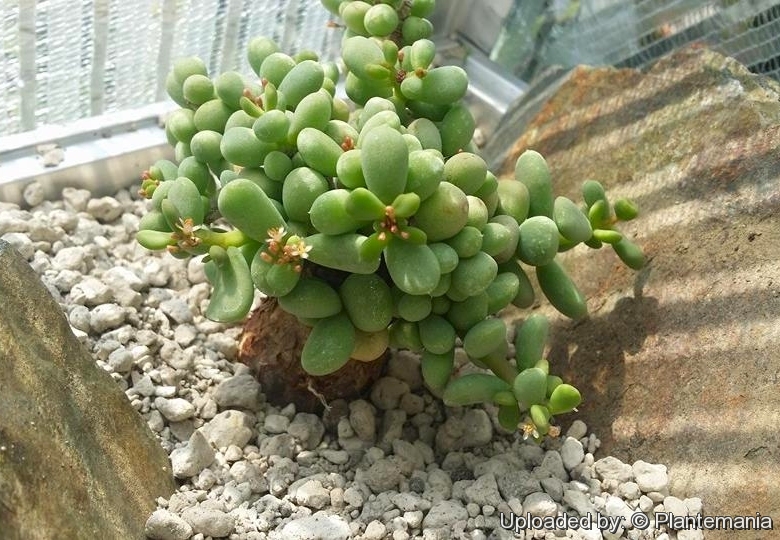
CERRARIA pygmaea in flowers
Origin and Habitat: Ceraria pygmaeaSN|23514]]SN|23514]] is found near Grootderm in the northern Richtersveld in Namaqualand (Cape Province, South Africa) and across the Orange River to south of Luderitz in Namibia.
Habitat and ecology: Ceraria pygmaeaSN|23514]]SN|23514]] grows in hot hills in the quartz fields of Richtersveld where so many other extreme succulent plants occur, and has a remarkable growth-form. Like Anacampseros alstoniiSN|25187]]SN|25187]] it has an irregular, knotty caudex almost completely buried in the ground, and which merges into an irregular, knotty, fleshy caudex.
Synonyms:
- Ceraria pygmaea (Pillans) G.D.Rowley
- Portulacaria pygmaea Pillans
Description: Ceraria pygmaeaSN|23514]]SN|23514]] is a dwarf dioecious, more or less evergreen, glabrous, succulent plants or mini-shrub that, as it matures, it develops a fat tuberous water-storing rootstocks to about 7-10 cm wide. The rootstock is a morphologically hardly identifiable tissue complex, composed of parts of the root, the hypocotyl, the epicotyl and the shoot. Plants with such tissue complexes are called caudiciforms. The plants are compact and bear a large number of very short branches, and forms small mounds up to 200 mm tall and 300 mm in diameter. The small succulent leaves are somewhat bluish or yellowish with a finely warty surface, and the tiny flowers are white to pale pink. Ceraria pygmaeaSN|23514]]SN|23514]] is one of the few succulent plants that stores water in both the trunk and leaves.
Stem: Erect, robust and woody at the base with rough bark, branches cylindrical, somewhat fleshy, stiff, nearly dichotomously branched, lower branches spreading, upper ones spreading decurved, young branches 2 mm in diameter with a silver-gray bark.
Leaves: Thick, sessile, decussate, jelly bean like (9-)11-14(-15) mm long, 6-9 mm across, young leaves 3-4 mm thick, sessile, spreading, ovate- wedge-shaped, tip rounded and minutely acute, rough, covered by roundish papillae, blue-green, later yellowish- green. The leaves fall off almost to the touch. However, new leaves will grow.
Flowers: Small, inconspicuous, pale pink, usually in terminal clusters of 2-6.
Bibliography: Major references and further lectures
1) Doreen Court “Succulent Flora of Southern Africa” CRC Press, 01/Jun/2000
2) G. D. Rowley: “Ceraria”. In: Urs Eggli “Illustrated Handbook of Succulent Plants: Dicotyledons” Springer Science & Business Media, 2002
3) Gordon Rowley “Caudiciform and Pachycaul Succulents: Pachycauls, Bottle-,Barrel-And Elephant-Trees and Their Kin a Collector's Miscellany” Strawberry Press. June 1st 1987
4) D.J,Von Willert, B.M.Eller, M.A.Werger, E. Brinckmann & H.-D. Ihlenfeldt. “Life Strategies of Succulents in Deserts: With Special Reference to the Namib Desert” CUP Archive, 1992
5) Hermann Jacobsen “Abromeitiella to Euphorbia” Blandford Press, 1960
6) Werner Rauh “The Wonderful World of Succulents: Cultivation and Description of Selected Succulent Plants Other Than Cacti” Smithsonian Institution Press, 1984
7) “Botanica: The Illustrated A-Z of Over 10,000 Garden Plants and how to Cultivate Them” Mynah, 1997
8) Gordon Douglas Rowley “Taxonomic innovations for the IOS Lexicon.” In: Bradleya. 14:82 1996
9) Wikipedia-Autoren, siehe Versionsgeschichte “Ceraria pygmaea” Wikipedia, Die freie Enzyklopädie. Versions-ID der Seite: 11862662918. Mai 2013 http://de.wikipedia.org/w/index.php?title=Ceraria_pygmaea&oldid=118626629 30. Oktober 2014
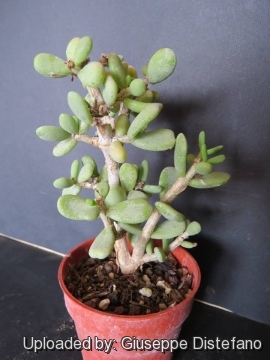
Ceraria pygmaea Photo by: Giuseppe Distefano
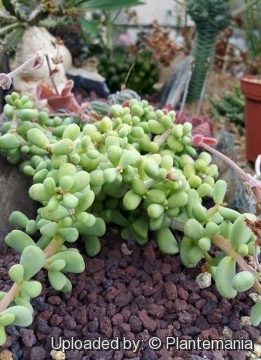
Ceraria pygmaea Photo by: © Plantemania
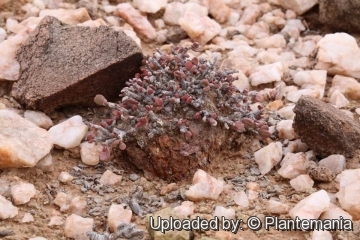
Ceraria pygmaea in habitat. Photo by: © Plantemania

Ceraria pygmaea. Fruiting habit. Photo by: © Plantemania
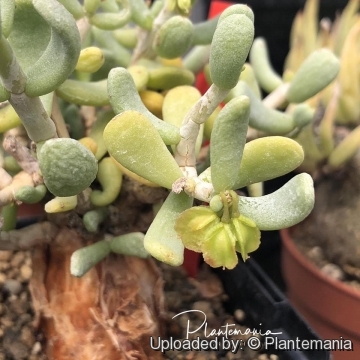
Ceraria pygmaea Photo by: © Plantemania
The gallery now contains thousands of pictures, however it is possible to do even more. We are, of course, seeking photos of species not yet shown in the gallery but not only that, we are also looking for better pictures than those already present. Read More...
Cultivation and Propagation: Although regarded as a choice and difficult plant, in cultivation it is relatively easy but very slow growing and seems to want to grow all the year round in the greenhouse. It is a particular favourite of caudiciform plant enthusiasts.
Growth rate: Plants grow very slowly and caudex take many years to enlarge. Clustering in cultivation, if grown correctly, it will reward the grower with generous displays of tiny flowers.
Caudex exposure: The remarkable tuberous rootstock (caudex) is often raised above the soil line so that this can be seen and more readily appreciated. For best results the tuber must be exposed only when plans become mature enough, usually after several years (8-12 or more years) of underground growth, as the exposed caudex will no longer increase in size once it has been lifted above the soil line.
Potting medium: Since roots are quite shallow, use a cactus mix or add extra perlite or pumice to regular soil potting soil. A gritty, very free-draining compost is suitable, and clay pots help the plants to dry out between watering. For best results, use a shallow pot, and only use the smallest diameter pot that will accommodate the plant.
Fertilization: Need a perfect fertilizer diet in summer. Use preferably a cacti and succulents fertilizer with high potassium content including all micro nutrients and trace elements or slow release fertilizer.
Watering Needs: Water normally in the growing season from March to October. No water should ever be allowed to stand around the roots. Keep almost completely dry in winter. The swollen caudex makes it very tolerant of under watering. Seedlings and rooted cuttings are more sensitive and cannot tolerate stagnant water around their roots (especially in winter) as this species comes from very dry areas.
Hardiness: It is quite frost resistant if kept dry, hardy as low as -5° C. It can be grown outdoors in the summer months to benefit from direct exposure to light, and especially exposure to high summer temperatures. Recommended Temperature Zone: USDA 10-12.
Sun Exposure: This plant has an excellent heat tolerance, and need full sun to light shade exposures. High levels of light are needed to flower and for good plant development.
Rot: Rot it is only a minor problem with Avonia if the plants are watered and “aired” correctly. If they are not, fungicides won't help all that much. The plant turns immediately to mush when over watered, or watered out of season. Care must be given in watering, keeping them warm and wet while growing, and cooler and dry when dormant.
Reproduction: Seeds or cuttings. The seeds are sown on the surface in gritty mineral-based soil. Then put the plastic pot in a ziplock ba. Fill in the ziplock bag as much tap water with a few drops of universal fertilizer, so that after the absorption of the substrate a few mm of water remain on the bottom. Then close the ziplock bag. More watering is not required because no moisture evaporates through the ziplock bag Seed germinate at 15-21°C. The resulting micro-climate provides ideal conditions for germination. Germination usually occurs within about a week or two.There is no pre-treatment of the seeds required.
| Your Actions | |
|---|---|
| Back to Ceraria index | |
| Back to Portulacaceae index | |
 |
Back to Succulents Encyclopedia index |
Privacy stantement - Terms and conditions - How to cite - About us - Feedback - Donate



